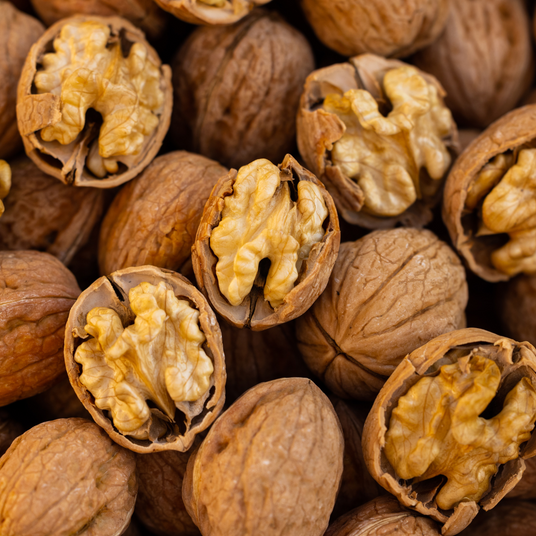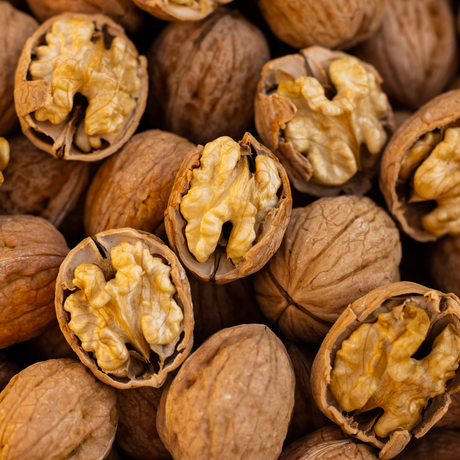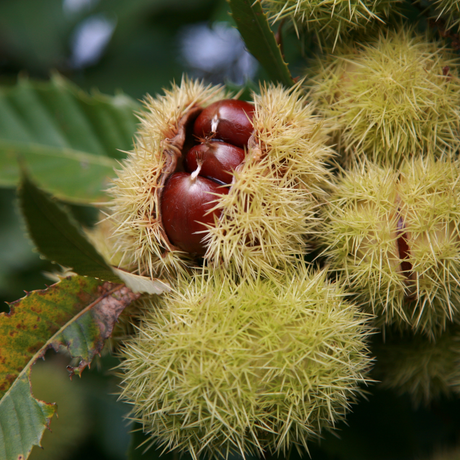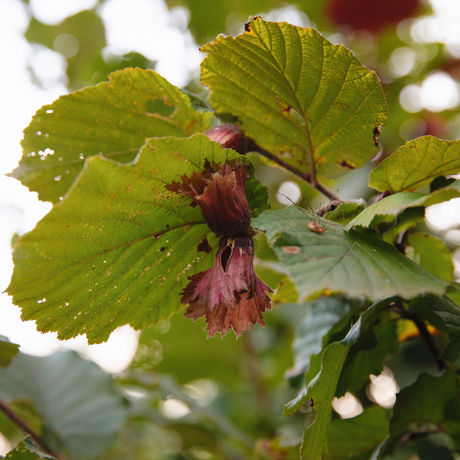Fruit and nut trees in pictures
In this video, Ruud shows you how to plant trees and shrubs.

Also read our growing guide on choosing and planting fruit trees.
Our other fruit trees
View allBuying a walnut tree: an investment in shade, taste and self-sufficiency
A walnut tree (Juglans regia, the Latin name) is an impressive tree that will look great in almost any garden. It's a large tree, making it particularly suitable for a large garden or gardens. It serves not only as a source of delicious nuts, but also as a shade provider, biodiversity enhancer, and eye-catcher. The walnut tree can grow up to 15 to 18 meters tall and between 8 and 11 meters wide. Low-stem walnut trees typically reach a height of 3 to 5 meters. Walnut trees are available in various heights, ranging from 50 to 700 centimeters. The leaves of the walnut tree are large, have a distinctive aroma, and have smooth edges. The walnut is the tree's edible fruit and falls from the tree when ripe. If you'd like to plant your own walnut tree, be sure to use organic material, stakes, and care for the roots to ensure healthy growth. The trees from our own nursery are of high quality. It's best to plant the walnut tree in the open ground, preferably in winter when the tree is dormant, so it can establish properly. Always choose the right location: a sunny, sheltered spot with plenty of space. Compared to other fruit trees and other trees, the walnut tree requires a little more space and attention, but maintenance is easy. Plukkers.com's walnut trees are selected for their vigorous growth, nut quality, and disease resistance – and offer years of garden enjoyment.
Why plant a walnut tree and where is the right location?
- Nuts from your own garden – Rich in omega 3 fatty acids, proteins and antioxidants.
- Beautiful, robust tree – Suitable as a solitary eye-catcher in a lawn or orchard.
- Longevity – A walnut tree lives for decades and bears prolifically.
- Easy care – Low in disease and low in maintenance.
- Biodiversity – Birds, insects and hedgehogs also benefit from the tree.
- Correct location – The walnut tree grows best in a sunny, sheltered spot with well-drained soil.
- Less maintenance than other fruit trees and other trees – A walnut tree generally requires less care and pruning than many other fruit trees and other trees.
- Natural Repellent – The scent of walnut tree leaves can repel mosquitoes and flies.
- Shady Crown – A walnut tree is a stately, fast-growing tree with an open crown that provides plenty of shade.
Types of walnut trees ( juglans regia )
Dreaming of your own walnut tree? Then you're spoiled for choice! There are several varieties, each with its own unique character and benefits. The common walnut tree (Juglans regia) is a real winner – you've probably heard of it. This beautiful tree surprises you with large, delicious nuts and such lovely dark green leaves. They grow into truly large specimens and are very hardy, but you do need to be patient: it usually takes eight to ten years before you can harvest your first delicious nuts.
Want to enjoy a bountiful harvest sooner? Then cultivated walnut trees are truly your best friend. These trees are grafted onto a specific variety and grow much faster. The best part is that they often produce larger fruits within three to five years! They're also selected for disease resistance and nut quality. Perfect if you're planting a young tree and don't want to wait years for results.
Then there are black walnut trees (Juglans nigra) – real eye-catchers with their dark trunks and characteristic aroma. These trees are especially beloved for their ornamental value and strong wood. The nuts are a bit harder in shell and less common to eat, but they are simply beautiful as an addition to larger gardens or orchards.
Whichever walnut tree you choose, a good start is essential. Plant your tree in a sunny spot in well-drained soil. Water young trees regularly, especially during periods of drought. A mature tree can handle a few knocks, but it appreciates extra attention during prolonged droughts. Prune your tree regularly (preferably in autumn) and remove only dead or diseased branches. This keeps healthy branches intact and your tree healthy. Prune the tree to create an open, sunlight-permeable shape. Walnut trees should be pruned in late summer or winter, when sap flow is minimal. The best time to prune a walnut tree is in October or November.
Specialty nurseries offer a wide selection of walnut trees, from young specimens to mature trees. Whether you choose a regular walnut, a cultivated variety, or a black walnut, with the right care and a suitable location, your walnut tree will truly become a valuable, green investment. Walnut trees can be purchased from various nurseries, such as Bomenbezorgd.nl and Bomenenzo.nl. Enjoy your garden!
Our recommendation from the collection
- Walnut tree Juglans regia
This classic walnut tree (Latin name: Juglans regia) grows into a large tree, ideal for a large garden. With this tree, you'll have your own walnut tree in your garden, producing delicious walnuts. Perfect for those who want a long-term harvest and the enjoyment of a beautiful tree in their own garden.
Walnut tree care and pruning
It is important to take good care of your walnut tree for healthy growth and a rich harvest.
- Planting time – The best planting period is from November to April, outside of frost. Planting in the ground is ideal during the winter, so the roots can establish well before spring arrives.
- Position – Sun or light shade, in fertile, well-drained soil.
- Space – Give the tree at least 6-8 metres of space around it to grow.
- Pruning a walnut tree – Pruning is important to maintain its shape, keep the walnut tree small, and encourage strong main branches. Lightly prune the tree no more than twice a year, preferably in summer to prevent bleeding. Remove weaker branches and inward-growing branches to keep the tree structure open and allow strong main branches to develop. Always maintain healthy, living branches and avoid overpruning, as removing too many branches can harm the tree. Always use clean pruning shears to prevent disease. Ensure the tree is neatly pruned after pruning, and be extra careful with young trees: prune carefully and support the natural shape.
- Water – Only provide extra water during dry periods and for young plants. Give young walnut trees, especially those planted in the ground, extra water and protect the roots from drying out.
- Planting hole – A planting hole for the walnut tree should be approximately 30-60 centimetres wide and 25-30 centimetres deep.
Harvesting and using
- When to harvest? In September/October, the ripe fruit, the walnut, falls from the tree naturally (tree fall).
- Uses – Eat fresh, dry, use in pastries or pesto.
- Storage – Dried walnuts can be kept for months in a cool, dry place. Stored this way, walnuts can last up to one to two years.
Your own nursery starts here
Planting your own walnut tree means investing not only in yourself but also in the future of future generations. As a large tree, the walnut tree is an impressive eye-catcher, especially suited to a large garden where it has plenty of room to grow and provide a bountiful annual harvest. Firmly rooted, robust, and suitable for any garden – discover your ideal walnut tree today at Plukkers.com.











